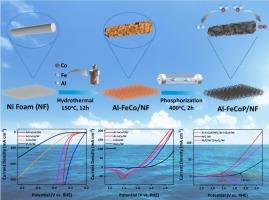构建具有超亲水/超疏水性的铝掺杂铁钴磷纳米片阵列,作为激活碱性整体水分离的双功能电催化剂
IF 6.3
2区 工程技术
Q1 ENGINEERING, CHEMICAL
引用次数: 0
摘要
氢被视为 "终极清洁能源",具有零污染、可再生、储量丰富等优点,有望缓解全球气候变化和能源危机等问题。设计合理的方法合成高效、廉价、稳定的水分离电催化剂迫在眉睫。在本研究中,我们在泡沫镍(Al-FeCoP/NF)上构建了具有超亲水/超疏水性的 Al-FeCoP 纳米片阵列。超亲水性和水下超疏表面加速了电解质的渗透和气泡的消散,从而消除了 "气泡屏蔽效应"。通过杂原子掺杂和磷化,电催化剂的电子结构得到调整,从而有效提高了催化剂的导电性。令人惊奇的是,所制备的 Al-FeCoP/NF 电极在碱性介质中表现出显著的活性,在 10 mA cm-2 的条件下,氢进化反应(HER)和氧进化反应(OER)的过电位分别仅为 121 mV 和 215 mV。当应用于整体水分离时,组装好的双电极电解槽只需要 1.56 V 的低电压就能提供 10 mA cm-2 的电流密度,并能维持 100 h 以上而无明显的活性衰减,从而提高了整体催化活性,体现了优越的长期稳定性。此外,利用丰富的风能和太阳能资源直接发电,然后在实验室条件下通过电解水将其转化为绿色氢气。这项工作为通过元素掺杂制造低成本、高活性的双功能过渡金属磷化物电催化剂用于绿色制氢提供了新思路。本文章由计算机程序翻译,如有差异,请以英文原文为准。

Construction of Al-doped FeCoP nanosheet array with superhydrophilic/superaerophobic characteristics as a bifunctional electrocatalyst for activating alkaline overall water splitting
Hydrogen is regarded as “the ultimate clean energy source”, with the virtues of zero pollution, renewability and abundant reserves, which is expected to alleviate problems including global climate change and energy crisis. Designing reasonable methods for synthesizing efficient, inexpensive, and stable electrocatalysts for water splitting is urgently needed. In this study, we construct Al-FeCoP nanosheet array on nickel foam (Al-FeCoP/NF) with superhydrophilic/superaerophobic properties. The superhydrophilic and underwater superaerophobic surface accelerate the electrolyte penetration and bubble dissipation, thereby taking the edge off the “bubble shielding effect”. The electronic structure of the electrocatalyst is tuned through heteroatom doping and phosphorization, which effectively enhances the conductivity of the catalyst. Strikingly, the resulting Al-FeCoP/NF electrode shows remarkable activity in alkaline media, which only requires an overpotential of 121 mV and 215 mV at 10 mA cm−2 for hydrogen evolution reaction (HER) and oxygen evolution reaction (OER), respectively. When applied for overall water splitting, the assembled two-electrode electrolyzer only needs a low voltage of 1.56 V to afford a current density of 10 mA cm−2 and can maintain over 100 h without the obvious activity attenuation, which enhances the overall catalytic activity and represents superior long-term stability. In addition, the abundant wind and solar energy resources are employed to generate electricity directly, which is subsequently convert into green hydrogen by the water electrolysis in laboratory conditions. This work provides a new idea for the manufacture of low-cost, high-activity bifunctional transition-metal phosphide electrocatalyst by element doping for green hydrogen production.
求助全文
通过发布文献求助,成功后即可免费获取论文全文。
去求助
来源期刊

Journal of water process engineering
Biochemistry, Genetics and Molecular Biology-Biotechnology
CiteScore
10.70
自引率
8.60%
发文量
846
审稿时长
24 days
期刊介绍:
The Journal of Water Process Engineering aims to publish refereed, high-quality research papers with significant novelty and impact in all areas of the engineering of water and wastewater processing . Papers on advanced and novel treatment processes and technologies are particularly welcome. The Journal considers papers in areas such as nanotechnology and biotechnology applications in water, novel oxidation and separation processes, membrane processes (except those for desalination) , catalytic processes for the removal of water contaminants, sustainable processes, water reuse and recycling, water use and wastewater minimization, integrated/hybrid technology, process modeling of water treatment and novel treatment processes. Submissions on the subject of adsorbents, including standard measurements of adsorption kinetics and equilibrium will only be considered if there is a genuine case for novelty and contribution, for example highly novel, sustainable adsorbents and their use: papers on activated carbon-type materials derived from natural matter, or surfactant-modified clays and related minerals, would not fulfil this criterion. The Journal particularly welcomes contributions involving environmentally, economically and socially sustainable technology for water treatment, including those which are energy-efficient, with minimal or no chemical consumption, and capable of water recycling and reuse that minimizes the direct disposal of wastewater to the aquatic environment. Papers that describe novel ideas for solving issues related to water quality and availability are also welcome, as are those that show the transfer of techniques from other disciplines. The Journal will consider papers dealing with processes for various water matrices including drinking water (except desalination), domestic, urban and industrial wastewaters, in addition to their residues. It is expected that the journal will be of particular relevance to chemical and process engineers working in the field. The Journal welcomes Full Text papers, Short Communications, State-of-the-Art Reviews and Letters to Editors and Case Studies
 求助内容:
求助内容: 应助结果提醒方式:
应助结果提醒方式:


